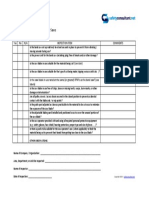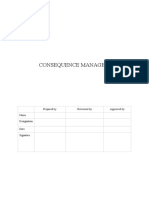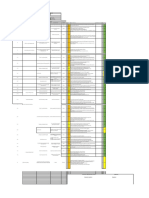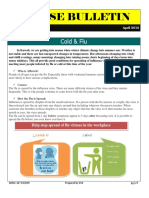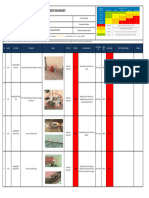Personal Protective Equipment Hazard Assessment
Personal Protective Equipment Hazard Assessment
Uploaded by
KrsnaPentayahCopyright:
Available Formats
Personal Protective Equipment Hazard Assessment
Personal Protective Equipment Hazard Assessment
Uploaded by
KrsnaPentayahOriginal Title
Copyright
Available Formats
Share this document
Did you find this document useful?
Is this content inappropriate?
Copyright:
Available Formats
Personal Protective Equipment Hazard Assessment
Personal Protective Equipment Hazard Assessment
Uploaded by
KrsnaPentayahCopyright:
Available Formats
FORM
Standard: Personal Protective Equipment
PERSONAL PROTECTIVE EQUIPMENT HAZARD ASSESSMENT
Task: Location:
Occupation: Department:
Evaluation Completed By: Date:
Eye and Face Protection
Type of Hazard Source of Hazard Description of Tasks, PPE
Engineering & Admin. Controls Required
In Place
Impact/Flying Working With, Near, or Around:
Objects/Dust Yes
Flying fragments, Chipping Buffing
Grinding Sanding No
objects, large chips,
particles, sand, dirt, Machining Woodworking
dust, etc. Drilling Powered
Chiseling Fastening
Riveting Masonry Work
Sawing Other:
Heat Working With, Near, or Around:
Burns Yes
Cutting Pouring Hot Metal
Welding Molten Metals No
Torching Other:
Hot Sparks
Chemical Liquids Working With, Near, or Around:
Chemical irritation or Yes
burns Pouring Mixing
No
Splash Hazards Irritating Mists
Washing/Cleaning Irritating Spray
Other:
Chemical Gases and Working With, Near, or Around:
Vapors Compressed Gas System Handling Yes
Chemical irritation or Other: No
burns
Light/Radiation Working With, Near, Or Around:
Poor vision; Damage to Yes
the eyes. Optical Radiation Torch Soldering
Cutting Torch Brazing No
Electric Arc Welding Glare
Gas Welding Other:
Biohazards Working With, Near, or Around:
Exposure to infectious First Aid/Emergency Care Treatment Yes
material Body Fluids No
Other:
Revision Date: 10/18/2012 Page 1 of 5
Copyright © 2012 The President and Fellows of Harvard College
Head Protection
Falling Objects Working Under:
Other workers using tools and materials Yes
that could fall No
Machinery or processes which might
cause materials or objects to fall
Warehouse racking where loose material
loads are handled or stored.
Other:
Overhead Object Interference Working Under or Near:
Conveyor belts carrying material Yes
Vertical lifts and other elevating work No
platforms
Other:
Foot Protection
Impact Hazards Working With:
Routine activities where Yes
objects heavier than 5 lb. Heavy Packages Heavy Parts/Equip.
Heavy Tools Other: No
could fall on feet
Heavy Objects
Compression Hazards Working With:
Roll-over hazards High Use of Carts or Pallet Trucks Yes
Handling Heavy Pipes or Logs No
Drum Handling
Other:
Puncture Protection Working Where There Is:
Puncture to shoe soles Yes
Nails Scrap Metal
Wire Screws No
Tacks Sharp Objects on
Glass Walking Surfaces
Large Staples Other:
Electrical Hazards Working With Or Near:
Electric shock or burns Exposed Electrical Conductors Yes
Energized Parts No
Electrical Switch Gear
Other Exposed Electrical Hazards:
Chemical Hazards Working With, Near, Or Around:
Irritation or burns Splash Hazards from Hot Or Corrosive Yes
Liquids No
Revision Date: 10/18/2012 Page 2 of 5
Copyright © 2012 The President and Fellows of Harvard College
Hand Protection
Chemical Hazards Working With or Handling:
Chemical irritation or burns Yes
Solvents Toxic Materials
Corrosives Other: No
Skin Irritants
Physical Hazards Working With Or Handling:
Cuts, punctures, abrasions, Sharp Objects Yes
rubbing/friction, or laceration. Sharp Tools No
Knives
Jagged Objects
Glass
Using, Cleaning or Dismantling
Equipment with Sharp Points Or Edges
Abrasive Materials (E.G. Sanders)
Other:
Thermal Hazards Working With Or Handling:
Burns Hot Material Yes
Molten Metal No
Hot Pipes, Steam, Or Liquids
Welding
Hot Work Activities
Other:
Cryogenic Hazards Working With Or In:
Frostbite Cold Materials Yes
Cold Weather No
Other:
Biohazards Contact During:
Exposure to infectious First Aid/Emergency Care Yes
material Custodial (Biological Response) No
Other:
Electrical Hazards Working on Or Near:
Electric shock or burn Energized Circuits of High Voltage (>600v) Yes
Other: No
Revision Date: 10/18/2012 Page 3 of 5
Copyright © 2012 The President and Fellows of Harvard College
Respiratory Protection
Inhalation Hazards Working With or Near:
Nuisance Dusts (Chemicals, Wood) Yes
Fibers (Asbestos, Etc.) No
Mists (Oils, Acids, Etc.)
Vapors (Solvents, Gases, Etc.)
Fumes (Torch Cutting, Welding,
Soldering)
Other:
Atmospheric Hazards Working In or Near:
Toxic Atmospheres Yes
Oxygen-Deficient Areas (Below 19.5% No
Oxygen)
Immediately Dangerous To Life Or Health
(IDLH)
Other:
Hearing Protection
Loud Noises Working in Area Exceeding 85 dBA:
Hearing loss Noise Level From Most Recent Noise Yes
Survey: No
Continuous Noise
Impact Noise
Intermittent Noise
Other:
Body Protection
Chemical Hazards Working With or Handling:
Chemical splash exposure Yes
Solvents Toxic by Skin
Corrosives Absorption No
Irritants Other:
Electrical Hazards Working With or Around:
Electric shock or burns High Voltage (>600v) Yes
Other: No
Fire Exposure Working With or Around:
Burns Fires Yes
Open Flames No
Other:
Fall Protection Working from unprotected heights
greater than 4 feet Yes
Other: No
Revision Date: 10/18/2012 Page 4 of 5
Copyright © 2012 The President and Fellows of Harvard College
Personal Protective Equipment – Hazard Assessment Summary
Task: Location:
Occupation: Department:
Evaluation Completed By: Date:
PPE Category PPE Required for this Department
Eye and Face Protection Yes Safety Glasses w/ Side Face Shield Filtered Lenses
No Shields Welders Face Shield Impact Goggles
Chemical Goggles Welding Shields Other: ___________
Head Protection Yes Hard Hat-Class G (Proof Tested to 2,200 Volts)
No Hard Hat-Class E (Proof Tested to 20,000 Volts)
Hard Hat-Class C (No Electrical Protection)
Other: _______________
Foot Protection Yes Safety Shoes Electrical Hazard Soles: Material:
No Boots Leather Neoprene
Metatarsal Guards Rubber PVC
Boot Cover Other: ____________ Poly/Nylon
Hand Protection Yes Gloves: PVC Heat Resistant
No Wrist Length Nitrile Welding
Elbow Length PVA Cold Resistant
Shoulder Length Latex Electrical Resistant
Chemical Resistant Abrasion Resistant Anti-Static
Butyl Cut Resistant Other: ___________
Neoprene Puncture Resistant
Respiratory Protection Yes Air Purifying Airline Full-Face
No Dust PAPR Canister
Mist SCBA Cartridge
Fume Half-Face Other: ___________
Hearing Protection Yes Earmuffs Min. Noise Reduction Rating
No Earplugs Other: _______________
Body Protection Yes Apron Coveralls Insulating Covers
No Jacket/Coat Insulating Blankets Other: ___________
Long Sleeves
Fall Protection Yes
No
Comments:
_____________________ __________ __________________________ _________
Supervisor Date Environmental Safety Officer Date
Revision Date: 10/18/2012 Page 5 of 5
Copyright © 2012 The President and Fellows of Harvard College
You might also like
- RISK ASSESSMENT REPORT - George Municipality - Tender ENG0042016 Installation of Perimeter Concrete Palisade FeDocument10 pagesRISK ASSESSMENT REPORT - George Municipality - Tender ENG0042016 Installation of Perimeter Concrete Palisade FeemmyNo ratings yet
- Brahmaputra Cracker and Polymer Limited Lepetkata, Assam: Job Safety AnalysisDocument2 pagesBrahmaputra Cracker and Polymer Limited Lepetkata, Assam: Job Safety AnalysiszebmechNo ratings yet
- PPE Matrix UpdatedDocument6 pagesPPE Matrix UpdatedV SAMPATH RAONo ratings yet
- AKZO Oilfield Brochure 2011 CompactDocument32 pagesAKZO Oilfield Brochure 2011 CompactLê Công100% (1)
- 3.2 HIRA Register - BlankDocument3 pages3.2 HIRA Register - Blankshobha shelarNo ratings yet
- Concrete WorkDocument3 pagesConcrete WorkAbdul Ghaffar100% (1)
- Contractor Safety Induction Attendance SheetDocument2 pagesContractor Safety Induction Attendance SheetBalogun Isaac100% (1)
- RD Mine Hira (Vehicle and Driving) Location Risk Identification Control Measure Implementation Verification of Control MeasureDocument3 pagesRD Mine Hira (Vehicle and Driving) Location Risk Identification Control Measure Implementation Verification of Control Measureananthu.u100% (1)
- MDC - Power Tools Inspection Checklist FR-01-EHS-045-Rev.0Document1 pageMDC - Power Tools Inspection Checklist FR-01-EHS-045-Rev.0Aaron CastañedaNo ratings yet
- Risk / Impact Assessment Control Sheet: 000 Y N Y NDocument19 pagesRisk / Impact Assessment Control Sheet: 000 Y N Y NeDtutors. in100% (1)
- Safety Inspection Checklist Band SawsDocument1 pageSafety Inspection Checklist Band Sawsallu arunNo ratings yet
- 014 - Manual HandlingDocument4 pages014 - Manual HandlingPrem ChristianNo ratings yet
- Safety Statistics Audit ObservationsDocument2 pagesSafety Statistics Audit ObservationsSHAH NAWAZ SAEEDNo ratings yet
- HSE Weekly Inspection CLOSEOUT - R No. 01 Al SowaidiDocument7 pagesHSE Weekly Inspection CLOSEOUT - R No. 01 Al SowaidiAkhilesh ArunachalamNo ratings yet
- 5-Star Safety and Health Management System: Risk RegisterDocument3 pages5-Star Safety and Health Management System: Risk RegistersalmanNo ratings yet
- Hira RegisterDocument57 pagesHira RegisterSc Bc100% (1)
- First Aid Treatment Register: Project / Location: Job NoDocument1 pageFirst Aid Treatment Register: Project / Location: Job NoGopal ChoudharyNo ratings yet
- SHE Incident Investigation FormDocument3 pagesSHE Incident Investigation Formrozeena9824100% (2)
- Ohs-Pr-09-03-F10 (A) Planned Job Observation ReportDocument2 pagesOhs-Pr-09-03-F10 (A) Planned Job Observation ReportShafie Zubier100% (1)
- 2 Consequence Management ProcedureDocument10 pages2 Consequence Management ProcedureriyazaliNo ratings yet
- HSE-RA-014 Using of Cutting Torch - Rev 0Document15 pagesHSE-RA-014 Using of Cutting Torch - Rev 0عمروNo ratings yet
- PR 01 EHS 007 EHS Compliance AuditDocument7 pagesPR 01 EHS 007 EHS Compliance AuditClarabelle Mae Dela RosaNo ratings yet
- JHA-Mechanical Lifting1Document2 pagesJHA-Mechanical Lifting1john jaycoh veranoNo ratings yet
- 6 - Store InspectionDocument4 pages6 - Store InspectionabdulrehmanNo ratings yet
- 2.8c Risk Assessment - 001 Site Survey of Land Rev. July 2019Document7 pages2.8c Risk Assessment - 001 Site Survey of Land Rev. July 2019sadafnoor997No ratings yet
- Excavaten Work PermitDocument1 pageExcavaten Work Permitasem sawalmehNo ratings yet
- 03-F07 Job Safe Procedure Template - DAMMAM - NO. 01Document1 page03-F07 Job Safe Procedure Template - DAMMAM - NO. 01jawad khanNo ratings yet
- Observation Close Out FormatDocument1 pageObservation Close Out Formatsajin100% (1)
- Rev - Safety DocumentsDocument9 pagesRev - Safety DocumentsCar ThickNo ratings yet
- Curing Compound ApplicationDocument12 pagesCuring Compound ApplicationyashNo ratings yet
- RA For Snake BiteDocument5 pagesRA For Snake Biteshamroz khan100% (1)
- Step 2 Who Might Be Harmed and How?: What Are You Already Doing? Step 3: What Further Action Is Necessary?Document6 pagesStep 2 Who Might Be Harmed and How?: What Are You Already Doing? Step 3: What Further Action Is Necessary?XozanNo ratings yet
- Project HS Risk AssessmentDocument8 pagesProject HS Risk AssessmentParasNo ratings yet
- Hydro Static Test: Risk AssessmentDocument10 pagesHydro Static Test: Risk Assessmentmohammed a hseNo ratings yet
- Sop 04 Work Permit SystemDocument10 pagesSop 04 Work Permit Systemathul subashNo ratings yet
- Safety Debit NoteDocument1 pageSafety Debit Notealmamunmolla96No ratings yet
- OHSE Project HIRA - Fencing Work - R 01Document8 pagesOHSE Project HIRA - Fencing Work - R 01Pankaj SinghNo ratings yet
- Risk Assessment: Kitchen - HomeDocument5 pagesRisk Assessment: Kitchen - HomesonofoddinNo ratings yet
- Risk Assessment - House and BuildingDocument1 pageRisk Assessment - House and Buildingnayanahari0% (1)
- First Aid Kid ListDocument4 pagesFirst Aid Kid ListHairul Nizam Bin Mohd SalimNo ratings yet
- Hira Fan & Components Lifting ShiftingDocument4 pagesHira Fan & Components Lifting ShiftingBilal QureshiNo ratings yet
- Issue-Based Risk Assessment Sub-Contractor ITS Filters CleaningDocument5 pagesIssue-Based Risk Assessment Sub-Contractor ITS Filters CleaningAhmed AbdulmajeedNo ratings yet
- Coshh Assessment: Hi-Stick Spray Paint Contract Number:: Substance Properties and Hazards LabelsDocument4 pagesCoshh Assessment: Hi-Stick Spray Paint Contract Number:: Substance Properties and Hazards LabelsSafety ExpertNo ratings yet
- Working at Heights Translab and PBDocument1 pageWorking at Heights Translab and PBCIDI Avida Towers VergeNo ratings yet
- RA For Builders Work A59Document11 pagesRA For Builders Work A59Sajid ShahNo ratings yet
- Contractor Personnel and Safety Statistics Monthly Summary - Form S2052Document1 pageContractor Personnel and Safety Statistics Monthly Summary - Form S2052Safety professionalNo ratings yet
- Risk Assessments - StoreDocument5 pagesRisk Assessments - Storederwaishjee1100% (1)
- EHSWP002 - Night Work PermitDocument2 pagesEHSWP002 - Night Work Permitloganathan100% (1)
- Site Risk Register: Site Name: Rosebery ExDocument4 pagesSite Risk Register: Site Name: Rosebery Exvatasa100% (1)
- SWMS Loading and Unloading Vehicles WHS.127 V002.1Document18 pagesSWMS Loading and Unloading Vehicles WHS.127 V002.1Amit BhattNo ratings yet
- PCR-LP-362-Tower Crane Dismantling (LTM1450-8.1)Document17 pagesPCR-LP-362-Tower Crane Dismantling (LTM1450-8.1)Geethika SandaruwanNo ratings yet
- Contractor's EHSS Evaluation by PMT EHSS PK CLC Project FMO Jan 2020Document5 pagesContractor's EHSS Evaluation by PMT EHSS PK CLC Project FMO Jan 2020ManPower RecruitingNo ratings yet
- Samet Daily Scaffold Safety Inspection ReportDocument1 pageSamet Daily Scaffold Safety Inspection Reportyohanes aprinusNo ratings yet
- Hse Bulletin: Cold & FluDocument2 pagesHse Bulletin: Cold & FluRanjan PradhanNo ratings yet
- HSE Inspection Report - 11 Nov 2023Document1 pageHSE Inspection Report - 11 Nov 2023noumanqamar61No ratings yet
- F-Sp-Hse06-01 Rev 03 Hira NewDocument14 pagesF-Sp-Hse06-01 Rev 03 Hira Newvishal bailurNo ratings yet
- SJCPL-HSE-FR-22 Near Miss Incident FormDocument1 pageSJCPL-HSE-FR-22 Near Miss Incident FormVikas Yamagar100% (1)
- 15 (1) HIRA - Shifting of Const MaterialDocument3 pages15 (1) HIRA - Shifting of Const MaterialSk younusNo ratings yet
- Deshuttering WorkDocument1 pageDeshuttering WorkAhmed AbdulfatahNo ratings yet
- R-20 Two Way Communication FormDocument1 pageR-20 Two Way Communication FormSandeep KumarNo ratings yet
- Personal Protective Equipment Hazard AssessmentDocument5 pagesPersonal Protective Equipment Hazard AssessmentZaki AziziNo ratings yet
- Wound HillDocument8 pagesWound HillEdward KurniawanNo ratings yet
- K-Max 10 Gensets TDSDocument2 pagesK-Max 10 Gensets TDSmoaazabubakrNo ratings yet
- MitDocument361 pagesMitrsiddharth2008No ratings yet
- PDS Perkadox 33 - UnlockedDocument4 pagesPDS Perkadox 33 - UnlockedreyesNo ratings yet
- Gear Oils: Axle & Manual TransmissionsDocument4 pagesGear Oils: Axle & Manual TransmissionsAli ShokoohiNo ratings yet
- Autoclave TapeDocument1 pageAutoclave Tapeantoniod179237No ratings yet
- Construction Machinery Brochur IGUSDocument24 pagesConstruction Machinery Brochur IGUSjorgew2050No ratings yet
- Chapter 1 Production Planning and ControlDocument32 pagesChapter 1 Production Planning and Controlnescafe okNo ratings yet
- Stone and Reinforced MasonryDocument38 pagesStone and Reinforced MasonryAarthi JosephNo ratings yet
- A Business Plan For The Production of Crumb Rubber by Solid State Shear Extrusion EnPRO351 Spring2003 Final ReportDocument29 pagesA Business Plan For The Production of Crumb Rubber by Solid State Shear Extrusion EnPRO351 Spring2003 Final ReportpedroNo ratings yet
- PHMSA Natural Gas Incidents 2010 To 2015Document150 pagesPHMSA Natural Gas Incidents 2010 To 2015Anonymous Pb39klJNo ratings yet
- Manual/Transfer Case: (The Other Gear Boxes)Document2 pagesManual/Transfer Case: (The Other Gear Boxes)trebz36No ratings yet
- Study of FusesDocument3 pagesStudy of Fusesviksoni100% (1)
- Tank Farm MaintainanceDocument4 pagesTank Farm MaintainanceNavya MishraNo ratings yet
- Plan Review Checklist: GeneralDocument4 pagesPlan Review Checklist: GeneralArthur YanezNo ratings yet
- Ee2403-Special Electrical Machines Unit I - Synchronous Reluctance Motor Synchronous Reluctance Motor ConstructionDocument8 pagesEe2403-Special Electrical Machines Unit I - Synchronous Reluctance Motor Synchronous Reluctance Motor ConstructionVijaya KumarNo ratings yet
- LNG Tech 2Document28 pagesLNG Tech 2genergia50% (2)
- Sap Inspection Lot Status - 4 Jan 2017Document3 pagesSap Inspection Lot Status - 4 Jan 2017bahrian907No ratings yet
- CM1 Din 2012Document248 pagesCM1 Din 2012Aurel ZimbruNo ratings yet
- Chiller Carrier - 30gt-52siDocument32 pagesChiller Carrier - 30gt-52siZJ Limited (ZJLimited)No ratings yet
- Creating Novel Furniture Through Topology Optimization and Advanced Manufacturingrapid Prototyping JournalDocument10 pagesCreating Novel Furniture Through Topology Optimization and Advanced Manufacturingrapid Prototyping Journalfrank8848No ratings yet
- Geosynthetics in Road ConstructionDocument45 pagesGeosynthetics in Road ConstructionMahesh KoppakaNo ratings yet
- 1.daftar Harga Suku CadangDocument2 pages1.daftar Harga Suku CadangCahyadi AndhikaNo ratings yet
- Brochure DowDocument8 pagesBrochure DowLucas Bissoli100% (1)
- Expt: 1.: Practice Correctly Safety Procedures in The WorkshopDocument10 pagesExpt: 1.: Practice Correctly Safety Procedures in The WorkshopKamranNo ratings yet
- Oedometer TestDocument5 pagesOedometer TestAshokan Keloth100% (1)
- Thin Slab CastingDocument5 pagesThin Slab CastingAnkit KumarNo ratings yet
- Ipc2012 90518Document8 pagesIpc2012 90518Marcelo Varejão CasarinNo ratings yet
- Failure Analysis of Cooling Fan GearboxDocument7 pagesFailure Analysis of Cooling Fan GearboxJoão Paulo VissottoNo ratings yet










